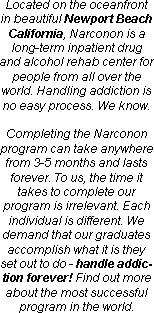
|
Navigate |
| Home |
| Kirstie Alley |
| Our 30th Anniversary |
| Never Turning Back |
| Narconon Endorsements |
| |
|
|
| |
|
|
| |
|
Facts About Drugs |
| FAQ About Ambien |
| FAQ About Ativan |
| FAQ About Cocaine |
| FAQ About Codeine |
| FAQ About Crack |
| FAQ About Darvocet |
| FAQ About Dexedrine |
| FAQ About Demerol |
| FAQ About Dilaudid |
| FAQ About Ecstasy |
| FAQ About GHB |
| FAQ About Heroin |
| FAQ About Hydrocodone |
| FAQ About Ketamine |
| FAQ About Lortab |
| FAQ About LSD |
| FAQ About Marijuana |
| FAQ About Morphine |
| FAQ About Meth |
| FAQ About Methadone |
| FAQ About Opiates |
| FAQ About Opium |
| FAQ About Oxycontin |
| FAQ About Percocet |
| FAQ About Percodan |
| FAQ About Ritalin |
| FAQ About Rohypnol |
| FAQ About Ultram |
| FAQ About Valium |
| FAQ About Vicodin |
| FAQ About Xanax |
  |
|
Resources |

|


 Print this article |  Send this article to a friend |  Add to Favorites |
FAQ
About Methadone
Is methadone more likely to kill you than heroin?
-By
Drs Marcel Buster & Giel van Brussel, MD
(Municipal Health Service
Amsterdam)
Based on literature and analysis of mortality figures Dr Russell Newcombe concluded that methadone programs as a form of harm-reduction possibly cause more victims than they prevent. We have doubts whether the conclusion about methadone is fully justified. Looking at the mentioned literature gives a one-sided view at the problem. Moreover, the conclusions drawn are beyond those justified by the results of the analyses. Several points of debate come to mind:
Methadone
is not an innocent substance; 'one's methadone maintenance dose is another's poison'
(2). A regular user of opiates develops a certain tolerance. Therefore, it is
possible that a tolerant person can function normally with dosages which can be
fatal to a non-tolerant person. Also, methadone dosage in the case of first entry
to the program has to be evaluated carefully. It is wise to begin with a low dosage
that has to be increased slowly in the course of weeks or even months. At entry
to the program it has to be carefully evaluated whether a patient has a clear
and unambiguous heroin dependence. In methadone maintenance programs, methadone
is dispensed to tolerant persons, moreover, this tolerance remains high because
of daily use of methadone. Therefore, it is not surprising that deaths at the
King's College Hospital caused by methadone were not those of participants of
a methadone maintenance program but were those of 'recreational' users of illicit
methadone. In cases where more than one drug is used, the drug responsible for
death due to overdose is difficult to establish. Moreover, the same drug prescribed
by physicians can also be bought on the street. In seventy percent of the deaths
due to overdose studied in Glasgow and Edinburgh a combination of different drugs
was found (3). Prescribed drugs such as temazepam were often encountered in deaths
in Glasgow. However, among only 14 of the 34 persons who died in 1992 and where
temazepam was found, this was prescribed by their physician. Because of the presence
of other drugs it is not clear whether temazepam really caused the death of these
people. Probably the combination of these different drugs was fatal to them. This
was also the case with the methadone deaths in Edinburgh. However, in Edinburgh,
the authors could not determine whether methadone was prescribed or not. Both
Hammersley and Obafunwa report that heroin/morphine deaths seldom occur in Edinburgh
(4). 'The fall of the deaths due to overdose in the Lothian and Borders Region
of Scotland (LBRS) after 1984 reflects in part the strict policing that took place,
in particular in the Edinburgh area'. 'The increase of methadone deaths is probably
due to the introduction of a street trend to use this agent as a substitute to
heroin'. The author suggests that methadone deaths are mainly caused by the use
of illicit methadone.
Wrong quotes: Dr. Newcombe assumes that the drug related
deaths among participants of a methadone program studied by Oppenheimer et al.,
were methadone related deaths (5). The correct quote should have been '18 of the
28 deaths were caused by overdose, an opiate as a primary overdose drug was mentioned
in only 22% of the cases'. Methadone is not mentioned as the cause of death of
these persons. The suggestion that methadone would be the cause of death ('invariably
methadone') is not based on the findings of Oppenheimer. Also, the suggestion
by Godse et al. that deaths due to medically prescribed drugs were caused by methadone
('invariably methadone') is not completely true (6). The most frequently encountered
drugs as main cause of death were barbiturates (287 of the 745 cases where the
used drugs were known). However, the number of deaths where methadone was implicated
was high; 107 cases. Dr Newcombe is quoting Harvey with 'up to 1977 methadone
accounted for the majority of drugs deaths attributed to strong analgesics'. However,
he did not quote the next sentence which says 'in 1979 the position has been reversed
with 11 heroin/morphine deaths to 2 methadone, possibly indicating a greater availability
of heroin' (7). Interpretation: For estimating the death rates, Dr. Newcombe uses
cumulative figures of drug users (only deceased persons are subtracted) from the
Home Office. Drug users have been registered since 1968. He assumes that two thirds
of this group still uses heroin. He multiplies this number by five and calculates
an annual death rate of 6 per 10.000 heroin users, which is a very low mortality
figure that is unlikely to be true. The low figure is probably caused by a considerable
overestimation of the actual number of active heroin users. The calculated mortality
figures on deaths caused by methadone are higher. Based on the calculation of
the death rates caused by methadone, Dr Newcombe accuses physicians of prescribing
a deadly drug. He concludes that clients of methadone programs are at high risk
of death due to an overdose. To draw conclusions like this he should restrict
his study to clients of methadone programs. Dr. Marks already made an effort in
this direction but he divided all methadone deaths by the officially registered
methadone clients and found an astonishingly high mortality rate (8). If he would
have limited himself to those occurring within the population of methadone clients
this mortality figure would have been much lower. There are studies were drug
users in methadone maintenance programs are compared with drug users on a waiting
list for methadone programs or drug users who left treatment. Grönbladh et
al. for example, report mortality among clients of methadone programs to be 1.4
% per year; among the drug users on a waiting list mortality was 7.2% per year
(9). Significantly, mortality due to heroin overdose in this group was high (4.8%
per year). Also Davoli et al. report that the risk of overdose is lower during
methadone maintenance. 'A high risk of overdose death occurred among subjects
who left treatment compared with those still in treatment (odds ratio 3.55, 95%
confidence interval 1.82-6.90)' (10).
Therefore, these figures suggest that participants of methadone programs are at lower risk of death due to overdose. However, this does not mean that methadone is an innocent substance. The high and increasing number of methadone deaths in Britain is alarming and certainly needs more attention. The first priority should be to establish whether the methadone causing death has been prescribed within a methadone program or bought on the street. It also should be evaluated at what point during the course of the methadone program death takes place. Further instruction doctors prescribing methadone could be necessary. The use of non-prescribed methadone without medical supervision can lead to high risks, especially when it is used as a substitute for heroin in order to get a 'high' instead of to prevent withdrawal symptoms. Physicians have to be aware of this danger and they should make sure that the prescribed methadone (as well as other psycho-active drugs) does not end up in the 'grey market'.
In our opinion heroin users can get great benefit from participation in a well-implemented methadone program. Denigration of methadone programs before a profound study of the real causes of the observed methadone deaths has been performed carries the risk that the baby will be thrown out with the bath water.
Q.) Where did Methadone come from?
A.) Methadone was originally developed by the Nazis during World War II. When the supply of opium was cut off, Nazi addicts like Hermann Goering (Commander in Chief of the Luftwaffe and Hitler's designated successor) wanted to avoid the possibility of withdrawal. He instructed the German drug companies to produce a wholly synthetic opiate that didn't need to rely on the poppy. The chemists came up with a drug that not only worked, but also lasted a long time. As a result, Methadone has become the drug of choice for doctors who are trying to help users manage their opiate dependency. Heroin wears off after a couple of hours, thus requiring several hits each day. Methadone, on the other hand, lasts anywhere between 24 and 72 hours, depending on the dose that you take and on your individual metabolism.
Q.) How is Methadone used?
A.) Methadone is a (synthetic opiate) narcotic that when administered once a day, orally, in adequate doses, can usually suppress a heroin addict's craving and withdrawal for 24 hours. Patients are as physically dependent on methadone as they were to heroin or other opiates, such as Oxycotin or Vicodin. Each time an addict uses heroin, there is a cycle of consisting of intoxication, initially, followed by a period of normal mental functioning which then yields to the discomfort of withdrawal and craving (flu-like symptoms with pain, anxiety and depression).
The cycle that repeats every 4 to 8 hours with heroin is eliminated by expert methadone maintenance treatment. This is possible because methadone is released more slowly into the system and lasts much longer than heroin and most other opiates. Short acting opiates, like heroin, hydrocodone and morphine perpetuate and/or create abnormal processes in the brain, which interfere with feeling normal and functioning normally. Taking methadone, instead, stops most aspects of this destructive process while normalizing important neurobiological functions. After stabilization on the proper dose, methadone does not produce the rush or “high” associated with heroin abuse.
Q.) What are the effects of Methadone?
A.) The most common side effects of Methadone are: drowsiness; lightheadedness, weakness, euphoria, dry mouth, urinary retention, constipation, and slow or troubled breathing. Some occasional side effects are: allergic reactions, skin rash, hives, itching, headache, dizziness, impaired concentration, sensation of drunkenness, confusion, depression, blurred or double vision, facial flushing, sweating, heart palpitation, nausea, and vomiting. The least common side effects of Methadone are: anaphylactic reactions, hypotension causing weakness and fainting, disorientation, hallucinations, unstable gait, tremor, muscle twitching, myasthenia gravis. The risks include kidney failure and seizures. Symptoms of overdose are: marked drowsiness, confusion, tremors, convulsions, stupor leading to coma, cold and clammy skin, hypotension, bradycardia.
Q.) What are the symptoms of a Methadone overdose?
A.) Body as a whole ~muscle spasticity
Respiratory ~difficulty breathing
~slow, shallow and labored breathing
~stopped breathing (sometimes fatal
within 2-4 hours)
Eyes, ears, nose, and throat ~pinpoint pupils ~bluish skin
~bluish fingernails and lips
Gastrointestinal ~spasms of the stomach and/or
intestinal tract ~constipation
Heart and blood vessels ~weak pulse ~low blood
pressure
Nervous system ~drowsiness ~disorientation ~coma
Q.) What does detoxification from Methadone involve?
A.) For detoxification treatment, methadone is administered under close supervision. During detoxification a patient may receive methadone when there are symptoms of withdrawal. Such symptoms are sneezing, yawning, tearing of eyes, runny nose, excessive perspiration, fever, dilated pupils, abdominal cramps, nausea, body aches, tremors and irritability. After several days of stabilizing a patient with methadone, the amount is gradually decreased. The rate at which it is decreased is dependent on the reaction of the individual . . . keeping withdrawal symptoms at a tolerable level is the goal.
Q.) Is Methadone addictive?
A.) In blind trials, users who were given both drugs orally were unable to distinguish between the effects heroin and methadone. An added problem for those using methadone to recover from heroin addiction is withdrawal. Withdrawal from heroin should be over after seven to ten days. Withdrawal from methadone though, can take up to a month or even longer.
Ironically, methadone used to control narcotic addiction is frequently encountered on the illicit market and has been associated with a number of overdose deaths. Tolerance and addiction to methadone is a dangerous threat, as withdrawal results from the cessation of use. Many former heroin users have claimed that the horrors of heroin withdrawal were far less painful and difficult than withdrawal from methadone.
Many people go from being addicted to heroin to being addicted to methadone, and continue with this "treatment" for years, fearing the withdrawal that will occur when they stop. Methadone does not have to be the way of life for former heroin addicts. Gradual cessation followed by a drug-free program of rehabilitation may be the answer for many sufferers.
If
you have a problem with methadone addiction call Narconon Southern California
drug rehab center, we can help 1800 US NO DRUGS

comment corner
 |
| drug rehabilitation saving taxpayers |
California taxpayers are saving more money than expected due to ... |
 |
| Study: Marijuana Causes Lung Damage |
New research finds that smoking three or four marijuana cigarettes ... |
 |
| Thanks to Online Pharmacies, Addiction Can Be Just a Click Away |
WASHINGTON -- Kelly Knable, a 34-year-old mother of three from ... |
 |
| Balancing pain and drug addiction |
Over the past two decades, two conflicting medical ideas have ... |
 |
| Clean break |
... |
 |
| State officials create prescription drug abuse task force |
TALLAHASSEE, Fla. -- State officials on Friday announced the creation ... |
 |
| Florida system often fails to catch Medicaid abuse at source |
FORT LAUDERDALE, Fla. - (KRT) - The victim's skin was ... |
 |
| Marijuana's rising threat: For more kids, use turns into addiction |
John Brown experimented with marijuana at age 10, and it ... |
 |
| Student gets state prison term for selling marijuana |
EASTON -- David Messina had his whole life ahead of ... |
 |
| Man charged in cocaine case forfeits $585,000 |
An Iowa truck driver arrested by Kentucky Vehicle Enforcement officers ... |
 |
| Cocaine Curtails Body's Ability to Cool Off |
In addition to triggering life-threatening cardiovascular episodes, cocaine can be ... |
 |
| Science for Cops |
I admit it: I'm a Law & Order fan. ... |
 |
| New Gene Therapy Could Help Quell Alcoholic Cravings |
One prevailing view of addiction holds that alcohol and other ... |
 |
| One Dose of Cocaine Primes the Brain for Addiction |
It isn't a myth: one dose of cocaine is all ... |
 |
| Marijuana Firmly Linked to Infertility |
Scientists from the University of Buffalo have smoked out what ... |
 |
| Moderate Alcohol Consumption Clouds Brain's Ability to Detect Mistakes |
It's common knowledge that a brain on booze doesn't function ... |
|
Narconon Pictures |
|
   |
|